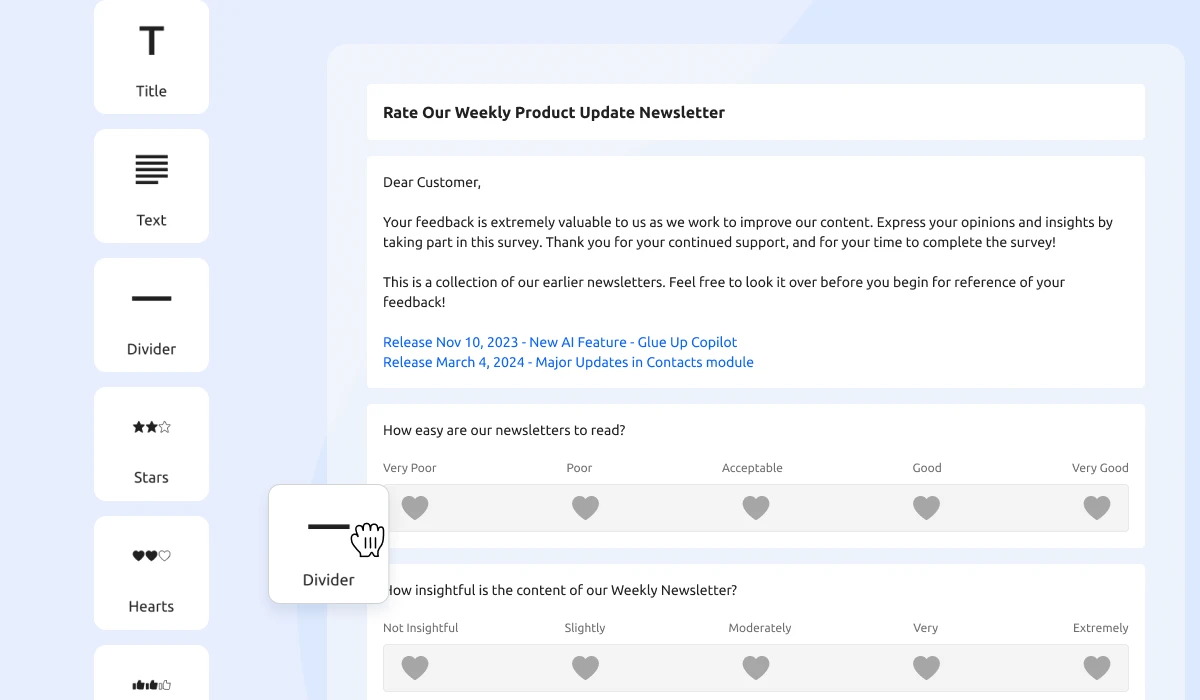
Surveys are a powerful tool for gathering insights and feedback, but getting people to respond can often be a challenge. A low survey response rate can lead to biased results and missed opportunities to understand your audience.
Whether you're conducting surveys for customer satisfaction, market research, or member engagement, improving your response rate is a must for collecting meaningful data.
This blog will discuss the top ways to increase your survey response rate, offering practical tips and strategies to confirm you get the valuable feedback you need. Read on to discover how to boost your survey's effectiveness.
Key Takeaways
- The survey response rate is the percentage of participants who complete a survey out of those invited. It helps gauge engagement and the quality of feedback.
- A response rate of 30% or higher is generally considered strong, though it can vary by industry and survey type.
- To increase survey response rates, keep surveys short, send them at optimal times, and offer incentives. Personalizing outreach and ensuring mobile compatibility also boost participation.
- To engage respondents, use clear language, thoughtful questions, and a visually appealing format. Regular reminders and ensuring confidentiality can also improve response rates.
- Glue Up simplifies survey creation and analysis with features like interactive dashboards, unlimited question types, and automatic data synchronization, making it easier to collect and understand feedback.
What is a Survey Response Rate?
A survey response rate refers to the percentage of individuals who complete a survey out of the total number of people who were invited to participate.
It's calculated by dividing the number of responses received by the number of surveys distributed and multiplying by 100. This rate serves as a key indicator of how many participants engaged with the survey and provided their feedback.
What Is Considered a Good Survey Response Rate?
A good survey response rate depends on various factors, such as the industry, the type of survey, and the audience. Generally, a response rate of 30% or higher is considered strong for most surveys.
However, this can vary based on the context in which the survey is conducted. Higher response rates typically indicate that your survey is engaging and relevant to the participants.
How to Calculate Your Survey Response Rate
Your survey response rate is calculated by dividing the number of responses received by the total number of surveys distributed and then multiplying that number by 100. This gives you the percentage of people who completed your survey out of those who were invited to participate.
Response Rate vs. Completion Rate – What’s the Difference?

The response rate refers to the percentage of people who responded to your survey out of those who were invited. In contrast, the completion rate measures the percentage of people who finished the survey after starting it.
While the response rate indicates how many people are willing to participate, the completion rate shows how many found the survey interesting or relevant enough to finish.
What Are The Benefits of a High Response Rate?
A high survey response rate has several benefits. It ensures that the data collected is more representative of the entire target population, leading to more accurate insights. It also increases the credibility of your survey results, making it easier to draw reliable conclusions.
Additionally, a higher response rate can reduce the margin of error, providing a clearer picture of the opinions or behaviors being measured.
Tips to Increase Survey Response Rates
There are many strategies to boost survey response rates. Effective techniques can significantly enhance the likelihood of getting valuable feedback from your audience.
Let’s explore a few key tips to achieve higher response rates:
Keep Surveys Short and Simple
One of the most effective ways to boost your survey response rates is to keep the surveys short and straightforward. Participants are more likely to complete a survey if it doesn't take too much of their time.
Aim to make your survey concise, focusing only on the most essential questions. This will not only respect the participants' time but also increase their likelihood of completing it.
Send Surveys at the Right Time
Timing is crucial to getting higher response rates. Sending your survey at a time when your audience is most likely to check their emails or engage with their devices can significantly impact participation.
For example, mid-week days like Tuesday or Wednesday and times around mid-morning or early afternoon often yield better results.
Clearly State the Purpose
People are more likely to respond to a survey when they understand its purpose. Clearly explain why you are conducting the survey and how their feedback will be used. When participants see the value in their contribution, they are more motivated to take part.
Incentivize Participation
Offering incentives can be a powerful motivator for increasing survey response rates. Whether it's a small gift, discount, or entry into a prize draw, incentives can encourage more people to complete your survey. To maximize participation, make sure the incentive is appealing and relevant to your target audience.
Use Simple and Direct Language
Using simple and direct language in your survey can help participants understand and respond to your questions. Avoid jargon or overly complex phrasing that might confuse or frustrate respondents. Clear and concise language helps guarantee that participants can quickly grasp what is being asked, which can lead to higher completion rates.
Personalize Your Outreach

Personalizing your survey invitations can significantly increase response rates. Address participants by their names and tailor the message to reflect their specific interests or previous interactions with your organization. Personalized outreach makes respondents feel valued and increases their likelihood of participating.
Ensure Mobile Compatibility
In today’s mobile-driven world, many people access surveys on their smartphones. Ensuring that your survey is mobile-friendly can boost response rates, as participants can easily complete it on the go. Optimize the design for smaller screens and test the survey on various devices to make sure it looks and functions well.
Follow Up with Reminders
Sending follow-up reminders to those who haven’t responded can greatly improve your response rates. A gentle reminder can nudge participants who may have overlooked the survey or forgotten to complete it.
Timing these reminders appropriately is key; don’t send them too frequently, but verify they are sent soon enough to keep the survey at the forefront of your mind.
Guarantee Confidentiality
Assuring respondents that their answers will be kept confidential can help build trust and encourage participation. Clearly state how the data will be used and who will have access to it. When participants know their responses are secure, they are more likely to complete the survey honestly and thoroughly.
Enhance Visual Appeal
A visually appealing survey can capture attention and make the process more enjoyable for respondents. Use a clean, attractive design with intuitive navigation. Incorporating elements like progress bars, images, or well-organized sections can make the survey more engaging and less hectic to complete.
Ask Questions Thoughtfully

Craft your survey questions with care. Certify they are clear, concise, and easy to understand. Avoid leading or biased questions that could influence the respondents' answers. Thoughtful questions encourage honest and accurate responses, which can lead to higher completion rates.
Share Survey Results
Sharing the results of your survey with participants shows them that their input is valued and has an impact. It also builds trust and transparency. When people see how their responses contribute to decisions or improvements, they are more likely to participate in future surveys.
Target the Right Audience
Verify that your survey is sent to the most relevant audience. Tailor your questions and content to this group's interests and needs.
Additionally, targeting the right people will increase the likelihood of receiving responses from those who are genuinely interested in the topic, leading to higher quality and quantity of responses.
Consider the Survey's Relevance
Make sure the survey is relevant to your audience. The questions should align with the participants' experiences, interests, or concerns. If respondents find the survey relevant to their lives or work, they are more likely to take the time to complete it.
Create a Sense of Urgency
Creating a sense of urgency can motivate participants to complete the survey promptly. Mentioning deadlines or offering time-sensitive incentives can encourage faster responses. However, be careful not to pressure participants too much, as this could have the opposite effect.
Simplify the Process
Make the survey process as simple as possible. Reduce the number of steps required to start and complete the survey. Avoid unnecessary questions or complicated instructions. The easier it is to participate, the more likely people are to do so.
Boost Your Survey Results with Glue Up

Glue Up offers a comprehensive suite of survey solutions designed to enhance your feedback collection and analysis. Easily create surveys, quizzes, and polls to gather opinions and preferences from diverse audiences.
Collect Feedback Effortlessly
Create surveys of any kind with just a few simple clicks. Utilize professional templates to save time and ensure that your questions are effectively crafted.
Make Smarter Decisions
Gain instant visibility into survey results through interactive dashboards and profiles. This enables you to analyze data in real-time and make informed decisions based on accurate insights.
Ask Even Faster
Utilize available templates designed by experts to streamline the process and reduce the time spent on survey creation.
Unlimited Question Types
Support a wide range of question types, including event feedback, NPS, member satisfaction surveys, and brand awareness research.
Collect All Data Automatically
Enjoy automatic synchronization, flexible data handling, customizable branding, and real-time reporting to manage and review your feedback efficiently.
Consolidate and Understand Feedback
Access real-time insights with customizable dashboards and manage roles and permissions to ensure that data is secure and accessible to the right team members.
Take advantage of Glue Up's powerful survey solutions to elevate your feedback processes and drive better outcomes for your organization.
Book a demo to see how Glue Up can transform your survey management and data analysis.



